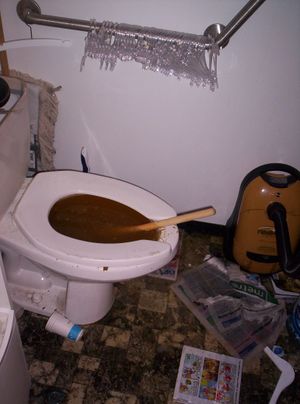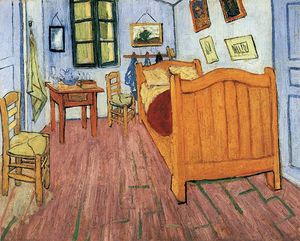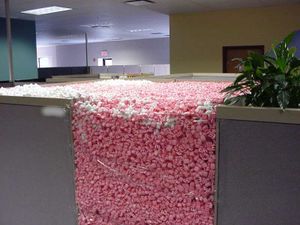OCD
“I don't have OCD, but I do have a list of friends with OCD in chronological order of birth, which I call every 15 minutes to make sure they're still alive.”
OCD or Omniscient Concept of Design is a paranormal ability whereby an individual possesses total knowledge of the intrinsic principles, processes and design of the order of the known universe. Fear and misunderstanding of this special power has led to it being mislabeled in public society as obsessive-compulsive disorder.

Origin[edit | edit source]
Because it has been largely dismissed as everything from an odd quirk of personality to an impairing mental illness, little is known about the source of this amazing gift. What is known is that the prevalence of Omniscient Concept of Design in the United States is estimated to be between 2 and 3%, although in Japan it is curiously high (70%). Family studies have discovered a 10% prevalence of OCD in first degree relatives, with an additional 8% having a significant but less complete understanding of the "wheels of creation". Additionally, studies of twins have established a 60% concordance rate, leading some to speculate that OCD is a trait likely to occur within people closely related to those within which it has already occurred. Wow. Investigative science hard at work.
Critics[edit | edit source]
A significant number (47797 as of 04:00, 27 Dec 2010 (UTC)) of behavioural scientists have pointed to the continuing presence of obsessive compulsive disorder in the Diagnostic and Statistical Manual of Mental Disorders (DSM) as proof positive that OCD is an illness, not a talent. But critics of those critics have pointed to the continuing presence of said behavioural scientists in their parents' basements, because they're too cowardly, disorganized, emotionally inept, and devoid of the basic life skills required to survive outside of the nest. So there.
Examples of order[edit | edit source]
Given the magnitude of creation, it would be difficult to list the rules and order for each facet of the known universe. But, given enough time and server space, this is in fact what this article intends to do. Even if it means sitting at this keyboard and typing 18 hour days through calloused fingers, carpal tunnel syndrome, unwanted bowel movements, and untimely evictions due to unpaid rent from unemployment, for each second of each minute of each hour of each day of each year for as many years as we all shall live—until this project is completed.
In the home[edit | edit source]
Kitchen[edit | edit source]

- In the pantry or cupboard, product labels should always face forward. No exceptions. Products with missing labels should be discarded immediately or donated to the Salvation Army. Identical items should be kept in the same rows and stacks. And be certain that each label is identical. The one offering a chance at a million dollars if you mail in the form on the back of the label is not the same as the one that doesn't mention a contest on it. And for God's sake, don't remove the label and send in the form. Mailboxes have cooties. Fine. OK. IF you absolutely must enter the contest, be certain to discard the can immediately, or donate it to the Salvation Army. And never intermix fruits and vegetables in the same rows. Or make alternating rows. Put one type on one side, and one type on the other. And don't think we forgot about the mailbox, because we didn't. Wash your hands. Start with the left hand, using copious amounts of antibacterial soap, and being absolutely careful to wash both sides, top and bottom, well past the wrist, and get soap between every finger. Then do the right hand. Then rewash the left hand because it touched the right while it was still dirty. Actually, do each hand three times each just to be sure. Maybe five times. Seven if it's keeping you awake at night. Don't forget to use a sterile paper towel to turn off contaminated water knobs or you will recontaminate yourself and need to rewash. Never use hand towels; they carry 432 varieties of bacteria.
Bathroom[edit | edit source]
- It goes without saying that the proper way to install a new roll of toilet paper is with the flap hanging out and away from the wall. This facilitates easy grasping and accurate delivery of the exact number of individual sheets desired. Only idiots install a roll with the flap touching the wall. Not only does it impede measured sheet access, it essentialy forces you to touch an unsanitary surface—the wall. Walls are basically vertical petri dishes. If you carried an electron microscope everywhere you went (and you should), the things you'd see would make your pubes uncurl. Honest. In any event, it is considered charitable behaviour to check each of the washrooms in each of your friends' houses regularly to ensure that this rule is being observed. If a roll is installed incorrectly, by all means switch it around. But don't touch anything else in the bathroom. You don't know when the last time it was cleaned. Just change the roll and leave immediately. Even if you really have to go. You should have gone at home. That'll teach you.
Take a few minutes to do the "Pee Pee Dance" behind closed doors until the urge to urinate subsides. Maybe if you'd remembered to wear your trenchcoat you could have smuggled in some bleach cleanser and a new, still plastic-wrapped toilet brush. But for the love of God, never, ever, under any circumstances should you ever enter a public washroom. Even if you really just want to check on the toilet paper rolls. There isn't enough antibacterial soap in the world to purge you of the microbial germs that live in the air of those cesspits. If, God forbid, you should find yourself at a Wal-Mart, in reciept of an urgent call from Number Two and public toilet use is your only option to a self-initiated raw sewage leak, abide by the example of the Eddie Kaye Thomas character "Paul Finch", and know that this is your penance for shopping at Wal-Mart in the first place. Place 12-18 layers of bathroom tissue in overlapping lengths over all sections where buttock-to-seat proximity is imminent. Germs are able to penetrate one layer of single-ply tissue per second, so prepare to drop your payload and then take off again immediately. Always flush public toilets with your foot and use a baseball-sized wad of tissue to open the stall door. Also, use your foot to press the soap dispenser handle that you know has been touched by thousands of contaminated hands and never cleaned since the date of installation. Catch the soap mid-air on the way down; yoga can help facilitate this level of flexibility. And never, under any circumstances should you touch the restroom door handle on the way out. At your option, use your foot, use another huge wad of paper, or charge out of the open door when the next sap comes stumbling in. Avoid body collision, because this produces additional contamination.
Bedroom[edit | edit source]

- Did you ever see that commercial where that guy is about to jump into bed, but then freezes in mid-air when he realizes that his sheets are dirty, and that sleeping in dirty sheets is like jumping into a pile of your own filth? I did. I must've watched that commercial about 47,797 times. I even videotaped it so I could still watch it after the company quit running those spots on the air. But even before then, I'd sometimes watch the tape. Usually it was in the middle of the night when I really needed to see it, and it was probably being broadcast on some channel somewhere, but I couldn't find it and really couldn't wait any longer, and they were mostly showing those great infomercials. Anyway, it made me sick to my stomach each time I watched it, but I had to watch it, you know? I even started to worry that I might be wearing out my videotape, so I made two dozen copies of it and wrapped them in archival paper and sealed them in a plastic water-tight container and locked them in a safety deposit box at my bank. I check it every Tuesday to make sure it's still there. Or sometimes every day. Anyway, back to the guy and those dirty sheets. Unless you were in the wrong line up at the baby assembly line in heaven, or your mom's intestines were connected to your cranial cavity when you were in the womb—whatever it is that you believe, this isn't a debate about creationism vs. evolution—anyway... Augh! I can't believe I said that. What a putrid and disgusting image. I can't believe I said that! Now I'll be distracted for hours because I can't get that picture out of my mind. I'm so stupid. I'll start again.
Unless you've got crap for brains, you should absolutely be changing your bed linens each day. No exceptions. Some people think it's okay to have a separate set of linens for each day of the week, but then that means that you've got dirty sheets sitting around on the floor, or worse, in the hamper, festering and reeking and polluting the air with bacteria that's probably only marginally less dangerous than what you'd breathe in at the dump. Though why anyone would want to go there, even just to check the air, I'll never know. If you want to see bears, turn on the TV and watch The Discovery Channel. Just wipe the TV buttons before you touch them. Or get your own personal remote control that no-one else is allowed to touch. But you should still wipe it clean even if it's really only you that touches it. Both before and after. Then go wash your hands. And if you want to get sick, forget about breathing in airbourne toxins, just cut to the chase and gargle with toilet water. God that's disgusting. I can't believe I just said that. Now I'll be distracted for hours because I can't get that picture out of my mind. I'm so stupid. Why do I always do this? I feel vaguely unclean all over. I need a shower. Yes, again.
In the workplace[edit | edit source]
Cubicle[edit | edit source]
- No wall hangings. Especially not "Dilbert" cartoons; the exposed newsprint just attracts floating organisms. Or, if there must be wall hangings, they must be framed, and the frames must match the color of the fabric. Preferably white, so that you can detect particulates before they grow out of control. Germs will float in over the cubicle walls from other cubicles; this must be prevented. Use an "Ionic Breeze" machine - better yet, two, no three Ionic Breeze machines to purify the air. (Don't bother with the traditional filter-based air purifiers; they don't work.) Even then, there could be a power failure; be sure to have a Uninterruptable Power Source (UPS) unit on standby, and keep plenty of filter masks handy. The filter masks should use, at most, 0.01-micron fibers, so forget about those NIOSH-Approved "N95 Disposable Particulate Respirator masks" that people use to avoid SARS. Only chumps buy those. Did you know that they only have a 95% filtration efficiency when subjected to a 03µm MMAD Sodium Chloride particle challenge? No? Question: How many hours a day do you spend reading labels? Answer: Not nearly enough.
Have at least two mini-vacs on hand, with plenty of spare batteries, to remove settled particulates from the keyboard, the mouse, and anything else that has moving parts. Replace the mousepad at least twice a week; more often if there are visitors. Never use a mechanical mouse. The grime on the insides of those things is absolutely disgusting. Only use an optical mouse or trackball, and even then, clean it with disinfectant as often as possible. Every 15 minutes is probably sufficient. Maybe every 10 minutes. Do not leave soiled coffee cups in the cubicle. Plastic disposable coffee cups with separate holders are safe, but above all, never use a ceramic coffee mug. Styrofoam cups are acceptable in an emergency. And above all, always brew your own coffee, with your own bottled water, in your own pot, which you bring home, every day, to wash in your dishwasher. At least twice.
Water cooler[edit | edit source]
- Don't even think about it. Bring your own bottled water in from home. Don't store bottles in the communal refrigerator; you don't have any idea what people could be putting in those things. Just keep the bottles in a nice, sterile plastic bag until you need one. And if you run out, just deal with it. Stay away from the water cooler. People like to get into conversations around those things, and the spittle gets all over everything. Things grow in spittle; it's a breeding ground for bio-hazardous organisms. Steer clear. In fact, stay away from people who have just been over there getting water - there could be contact transference. And don't place your cubicle's trash receptacle in such a way that people walking by could throw used paper water cups in it. Keep it hidden. And empty it every few minutes, just in case. But not anywhere near the water cooler.
Conference room[edit | edit source]
- This is the worst-case scenario. Try to avoid being invited to meetings if you can, but if you can't get out of it, at least wear one of those handy battery-operated miniature air purification units around your neck to catch some of the microbes emanating off of the disgusting carcasses of your sweaty drooling co-workers with their hordes of little children who bring all sorts of disease back from their schools and day care centers and bring it right into the conference room for you to absorb as if you didn't already have enough problems to deal with just being in the same building with them. Better yet, two battery-powered miniature air purification units plus the filter mask. Don't take chances. Try to sit in the corner, as close to the air-duct register as possible. Make sure you can do this by arriving for the meeting at least 15 minutes early. Use the advance time to arrange the chairs so that no one will be sitting within six feet of you. Try to remain calm as you prepare for the arrival of foreigners into your airspace, but do not breathe deeply. Button your shirt sleeves and tighten your tie to stop invasive airborne microbes, don't touch anything or pick anything up unless it's absolutely necessary, and even then, use a paper towel. And above all, don't even look at the doughnut tray! You might as well pop a cyanide pill. Better yet, two cyanide pills. Three, just to be sure.
